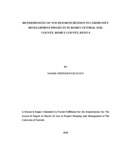| dc.description.abstract | The study sought to examine the factors influencing youth participation in community
development projects in Bomet Central Sub-county, Bomet County, Kenya. The study
was guided by the four objectives: to establish the influence of level of education on
youth participation in development projects Bomet Central sub county; to examine the
impact of the emerging national youth policy on the community in development projects
at Bomet Central sub county, to find out the relationship of accessibility to opportunities
and youth participation in development projects in Bomet Central sub county; and to
establish relationship of socio-cultural aspects and youth participation in development
projects Bomet Central sub county. This study used an exploratory qualitative research
design, which is useful when a researcher seeks to elicit a participant’s experiences,
perceptions and the meanings they attach to them. The study population consisted of
young people between the ages of 18 and 35 and the target population was 37,960 youth
in Bomet sub-County. A sample size of 396 was arrived at using Israel (2013) formula.
Stratified random sampling was used in selecting respondents because it gives each item
in the population an equal probability chance of being selected. The study used both
primary and secondary data. The researcher used primary data collected using
questionnaires to carry out the study. The questionnaires included structured and
unstructured questions. The study obtained secondary data from the published reports
which include periodicals, journals and internet. A pilot survey was also conducted for
the purpose of testing the validity of instrument before the main data collection. The testretest
technique was used to test the reliability. Analysis involved the production and
interpretation of frequencies counts and tables that describes and summarizes the data.
The data is presented using tables. The findings of this study are expected to contribute
immensely to the existing body of knowledge on youth participation in development
projects. Further, the findings can be used in formulation government policies that are
geared towards enhancing more participation from the youth. The study found out that
there was a significant association between education levels and youth participation in
development projects (χ2=78.93, P-value=0.000). It was established that 89.7% of the
respondents were aware of opportunities that can help them participate in development
projects. Accessibility was found to have significant effect on youth participation in
development projects (χ2=88.28, P-value=0.000). Chi-square test of independence
showed that there was significant association between government policies and youth
participation in development projects (χ2=130.219, P-value=0.000). The findings
indicated that there was a significant association between socio-cultural aspects and
youth participation in development projects (χ2=38.798, P-value=0.001). | en_US |

